Scottish House Condition Survey 2015: Key Findings
Includes updated fuel poverty rates, energy efficiency ratings, carbon emissions, Scottish Housing Quality Standard and disrepair.
4. Fuel Poverty
- In 2015 fuel poverty declined by about 4 percentage points compared to 2014: 30.7% or around 748,000 households were fuel poor and 8.3% (or 203,000 households) were living in extreme fuel poverty ( Table 29). This is a reduction of 97,000 households compared to 2014 when 34.9% or 845,000 households were fuel poor.
- Just over half (2.3 percentage points) of the reduction in fuel poverty rates between 2014 and 2015 can be attributed to the drop in the price of domestic fuels over this period. Around a third (1.3 points) can be attributed to improvements in the energy efficiency performance of the housing stock and the rest (0.6 points) can be explained by higher household incomes.
- Around half (52%) of fuel poor households have incomes above the poverty threshold, defined as £291 per week before housing costs for a couple without children ( section 4.5).
Figure 18: Fuel Poverty and Extreme Fuel Poverty since 2003/4
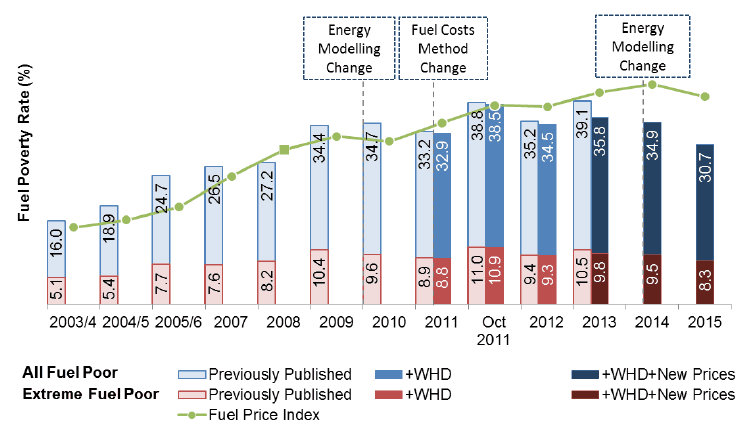
Note: Energy requirement underpinning fuel poverty estimate modelled on the following basis: 2003/4 - 2009: BREDEM - 12; 2010 - 2013: BREDEM 2012 v.1.0 and 2014 and 2015: BREDEM 2012 v.1.1.
4.1 Definition and Measurement of Fuel Poverty
136. As set out in the Scottish Fuel Poverty Statement, a household is in fuel poverty if, in order to maintain a satisfactory heating regime, it would be required to spend more than 10% of its income on all household fuel use [41] .
137. Under the 2001 Housing (Scotland) Act (section 88), the Scottish Government was committed to eradicating fuel poverty as far as practically possible by November 2016 [42] .
138. Extreme fuel poverty indicates that a household would have to spend more than 20% of its income to maintain a satisfactory heating regime.
139. A satisfactory heating regime is defined as follows:
- For "vulnerable" households [43] , 23°C in the living room (zone 1) and 18°C in other rooms (zone 2), for 16 hours in every 24.
- For other households, this is 21°C in the living room (zone 1) and 18°C in other rooms (zone 2) for 9 hours a day during the week and 16 hours a day during the weekend.
140. Although space heating is the largest component of the energy spend which underpins the fuel poverty estimate, there are other types of energy use that are also taken into account, such as water heating, lighting and appliance use, and cooking. These types of energy expenditure are estimated on the basis of a standard set of behavioral assumptions and do not reflect the actual energy use of the household, which may vary considerably depending on personal preference and priorities relative to other types of household expenditure.
141. Figure 19 shows that in 2015, on average, around 74% of the modelled household energy demand was from space heating, 13% from water heating, 11% from lighting and appliance usage, and 3% was accounted for by cooking.
142. The energy costs of maintaining a satisfactory heating regime and other uses of energy are modelled using data from the physical inspection of dwellings and the household interview conducted as part of the SHCS, as well as information on consumer fuel prices. The methodology for modelling the cost of energy use was updated for the 2014 Key Findings report and details were provided in the accompanying Methodology Notes [44] . The current report is based on the same method. The cost of the energy requirement includes an allowance for the bill rebate provided under the Warm Home Discount ( WHD) scheme and the £12 contribution of the Government Electricity Rebate (GER) delivered in Autumn 2015 to all electricity customers [45] .
Figure 19: Average Household Energy Consumption by End Use, 2015
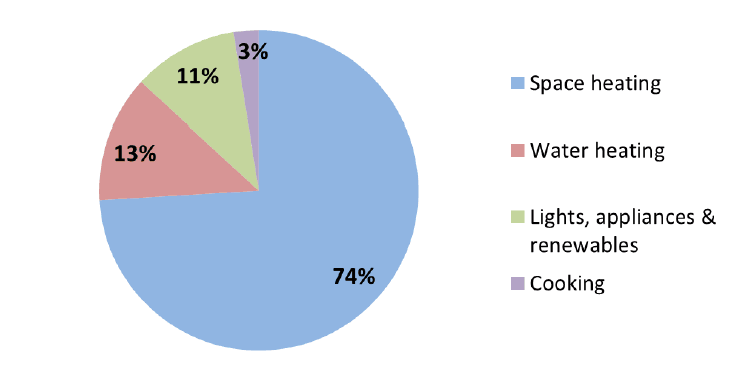
Note: Figures do not add to 100% due to rounding
4.2 Fuel Poverty and Extreme Fuel Poverty
143. Between 2014 and 2015 the rate of fuel poverty declined by around 4 percentage points. In 2015 there were around 748,000 fuel poor households representing 30.7% percent of all households. The number of fuel poor households fell by about 97,000 compared to 2014 when 34.9%, or around 845,000 households, were living in fuel poverty ( Table 29).
144. This is the lowest rate recorded by the survey since 2008.
145. Around 203,000 households, or 8.3% were living in extreme fuel poverty in 2015, compared to 229,000 households (or 9.5%) in the previous year.
Table 29: Estimates of Fuel Poverty and Extreme Fuel Poverty since 2011
| Fuel Poverty | Extreme Fuel Poverty | |||
|---|---|---|---|---|
| 000s | % | 000s | % | |
| 2011 | 779 | 32.9% | 209 | 8.8% |
| Oct 2011 | 911 | 38.5% | 257 | 10.9% |
| 2012 | 824 | 34.5% | 222 | 9.3% |
| 2013 | 860 | 35.8% | 236 | 9.8% |
| 2014 | 845 | 34.9% | 229 | 9.5% |
| 2015 | 748 | 30.7% | 203 | 8.3% |
Note: There are some discontinuities in the underlying methods as follows: figures for 2011 and 2012 allow for WHD adjustment only; 2013 include WHD and price source adjustment; 2014 and 2015 include WHD and price source adjustment and an updated BREDEM model
4.3 Drivers and Trends
146. Fuel poverty is affected by levels of household income, the price of fuel and the energy efficiency of housing. It is distinct from poverty in that, while low income is an important driver, it is not a prerequisite. As shown in Table 35, fuel poor households are found in all income bands. Around 15% of all fuel poor households had weekly income above £400 before housing cost, which places nearly all of these households in the top half of the income distribution ( Table 35). Fuel poverty also depends on the condition of the home and the cost of energy for space and water heating, cooking, lighting and running appliances.
147. In Table 30 and Figure 20 we have constructed indexes to compare trends in the three key drivers of fuel poverty since 2003. Measures of energy efficiency and household incomes are derived from SHCS data. The fuel price index is constructed from BEIS quarterly prices as described in section 4.3.1. Prices and incomes are presented in nominal, cash terms.
Figure 20: Trends in Fuel Price, Energy Efficiency and Median Income, 2003/4 - 2015
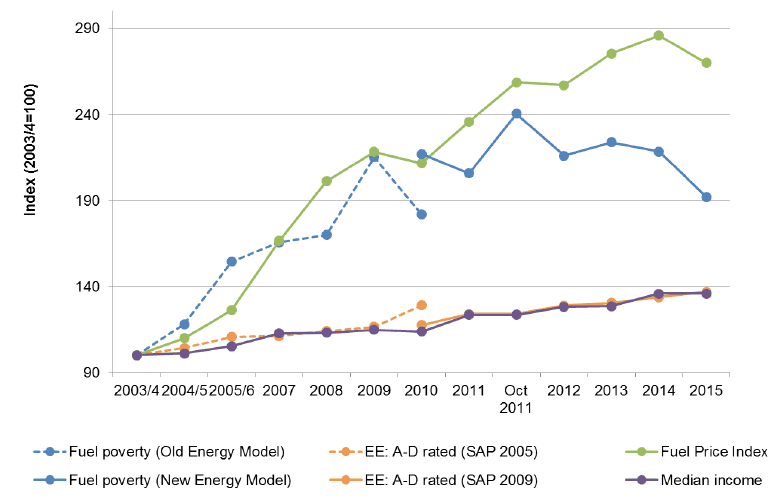
Note: All values indexed to 100 in 2003/4. Data for this chart are provided in Table 33. Fuel Price index constructed as described in section 4.4.1.
Fuel poverty energy requirement modelled on the following basis: 2003/4 - 2009: BREDEM - 12; 2010 - 2013: BREDEM 2012 v.1.0; 2014 and 2015: BREDEM 2012 v.1.1.
Fuel poverty costs as follows: 2011 and 2012 include WHD adjustment only; 2013, 2014 and 2015 include WHD and price source adjustments.
148. Since 2003 the proportion of dwellings rated A-D has increased by 37% and median household income has grown by 36%. Fuel prices have risen much faster, so that by 2015 they were more than two and half times (170%) their level in 2003.
149. Until 2012 the increase in fuel poverty has broadly mirrored the growth in the fuel price index [46] . Between 2013 and 2014 the rate of fuel poverty did not increase in line with the rise in the average fuel price index, and there are a number of factors that may have contributed [47] . In the last year, the decline in the price of fuel was reflected in a reduction in the fuel poverty rate.
Table 30: Fuel Price, Energy Efficiency and Income Indices
| Key Drivers of Fuel Poverty: Indices 2003/4=100 | ||||||||
|---|---|---|---|---|---|---|---|---|
| Survey year | Fuel poverty | Fuel Price Index | EE: A-D rated | Median income | ||||
| % | Ix | Ix | Rebased | % | Ix | £ | Ix | |
| 2003/4 | 16.0 | 100 | 47 | 100 | 62% | 100 | 16,000 | 100 |
| 2004/5 | 18.9 | 118 | 52 | 110 | 65% | 104 | 16,000 | 101 |
| 2005/6 | 24.7 | 154 | 60 | 126 | 69% | 111 | 17,000 | 105 |
| 2007 | 26.5 | 166 | 79 | 167 | 69% | 111 | 18,000 | 113 |
| 2008 | 27.2 | 170 | 95 | 201 | 71% | 114 | 18,000 | 113 |
| 2009 | 34.4 | 215 | 103 | 218 | 72% | 116 | 18,000 | 115 |
| 2010 | 34.7 | 217 | 100 | 211 | 73% | 118 | 18,000 | 114 |
| 2011 | 32.9 | 206 | 111 | 236 | 77% | 124 | 20,000 | 123 |
| Oct 2011 | 38.5 | 240 | 122 | 259 | 77% | 124 | 20,000 | 123 |
| 2012 | 34.5 | 216 | 121 | 257 | 80% | 129 | 20,000 | 128 |
| 2013 | 35.8 | 224 | 130 | 275 | 81% | 130 | 20,000 | 128 |
| 2014 | 34.9 | 218 | 135 | 286 | 83% | 134 | 22,000 | 136 |
| 2015 | 30.7 | 192 | 128 | 270 | 85% | 137 | 22,000 | 136 |
Source: BEIS Quarterly Prices; SHCS.
Note: Fuel poverty rates shown on BREDEM-12 basis (old energy model) up to 2009 and on BREDEM 2012 basis (new energy model) from 2010.
EE ratings shown on SAP 2005 basis up to 2009 and on SAP 2009 basis from 2010.
4.3.1 Fuel Costs
150. Data published by the Department for Business, Energy and Industrial Strategy ( BEIS) on the price of key fuels enables us to construct time series for the price of fuels for the average Scottish household over the longer term.
151. Using information from SHCS about the fuels used for space and water heating we can weigh the national quarterly fuel price indices published by BEIS [48] and produce an average index value for the price of the heating fuel requirement for Scotland. The results are shown in Figure 21.
152. Since the majority of Scottish households heat their properties with gas (79%), the national average index follows the gas index closely. Between 2003 and 2014 the price of the fuel mix required by the average Scottish household almost trebled. Between 2014 and 2015 the average index fell by 5.6%, primarily due to the drop in the price of oil and gas.
Figure 21: BEIS Fuel Price Indices and a Weighted Average for Scotland: 2003 - 2016
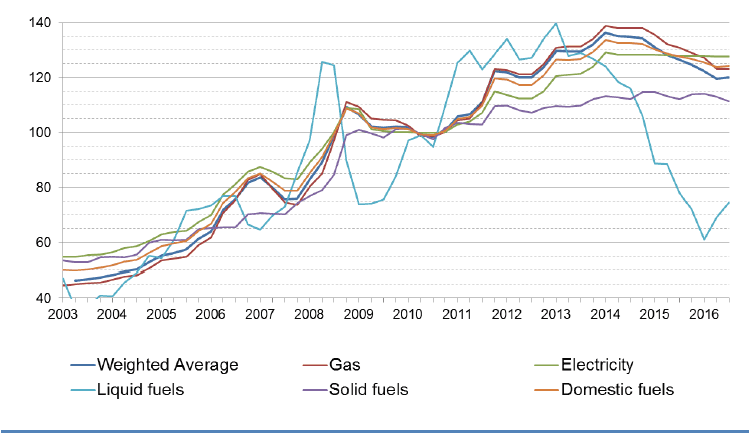
153. BEIS has published fuel price data up to September 2016. As in reality fuel use changes slowly, we assume that the fuel mix in Scotland in 2015 remains the same in order to provide a complete series into 2016. In the third quarter of 2016 the composite price of heating fuels continued to fall. This amounts to approximately 5.4% decrease on average 2015 levels to September 2016 ( Table 31).
Table 31: BEIS Current Fuel Price Indices and a Weighted Average for Scotland: 2003/04 - September 2016
| Year | Current fuel price indices | |||||
|---|---|---|---|---|---|---|
| Gas | Electricity | Liquid fuels | Solid fuels | Other fuels | Weighted Average | |
| 2003/04 | 45.7 | 55.5 | 38.7 | 53.7 | 50.6 | 47.3 |
| 2004/05 | 50.1 | 60.0 | 51.0 | 57.7 | 55.4 | 52.0 |
| 2005/06 | 57.4 | 66.3 | 69.5 | 63.0 | 62.7 | 59.7 |
| 2007 | 78.1 | 84.9 | 73.2 | 71.4 | 81.2 | 78.8 |
| 2008 | 93.4 | 98.1 | 109.3 | 84.9 | 96.2 | 95.1 |
| 2009 | 105.9 | 102.6 | 77.0 | 100.0 | 102.9 | 103.2 |
| 2010 | 100.0 | 100.0 | 100.0 | 100.0 | 100.0 | 100.0 |
| 2011 | 110.9 | 107.3 | 126.6 | 104.8 | 110.0 | 111.5 |
| Oct 2011 | 123.2 | 114.9 | 128.5 | 109.7 | 119.6 | 122.3 |
| 2012 | 122.5 | 113.4 | 130.5 | 108.6 | 118.7 | 121.5 |
| 2013 | 131.9 | 121.7 | 130.8 | 110.2 | 127.2 | 130.2 |
| 2014 | 138.2 | 128.5 | 116.0 | 113.2 | 132.8 | 135.2 |
| 2015 | 131.9 | 128.0 | 81.8 | 113.5 | 128.4 | 127.6 |
| to Sep 2016 | 124.5 | 127.7 | 68.2 | 112.8 | 124.5 | 120.7 |
BEIS Quarterly Energy Prices, Table 2.1.3. Indices supplied with 2010 = 100 https://www.gov.uk/government/statistical-data-sets/monthly-domestic-energy-price-stastics
Weighted average based on SHCS heating fuel use proportions, 2003/4 to 2015. 2016 proportions assumed unchanged from 2015.
4.3.2 Household Income
The SHCS is not designed to capture income comprehensively. Whole household income is not recorded, only that of the highest income householder and their partner. Income is reported in nominal terms and is not equivalised to take into account that households of different size and composition have different needs. Figures in this section therefore may not align with official statistics on household income and inequality.
154. In 2015, 50% of households earned £21,600 or more after tax, which was unchanged from 2014. This median income has increased by 19% in cash terms since 2010 (representing around £3,500).
155. Between 2014 and 2015 there was a 2% nominal increase in the average income of the surveyed households ( Table 32). This was not uniform across the distribution. There was a small decrease for the bottom income decile, and increase in the 2 nd and 3 rd bottom income deciles, while around the middle of the distribution average income remained broadly unchanged. The largest increase was observed in the second highest income decile.
Table 32: Mean Annual Income in Each Decile Group, SHCS 2014-2015
| Income Decile | Year | Percentage change | |
|---|---|---|---|
| 2014 | 2015 | ||
| 1 | £6,700 | £6,500 | -3% |
| 2 | £11,000 | £11,200 | 2% |
| 3 | £13,700 | £14,000 | 2% |
| 4 | £16,600 | £16,800 | 1% |
| 5 | £19,800 | £19,900 | 0% |
| 6 | £23,700 | £23,700 | 0% |
| 7 | £28,500 | £28,800 | 1% |
| 8 | £34,100 | £34,900 | 2% |
| 9 | £42,200 | £43,800 | 4% |
| 10 | £67,500 | £68,400 | 1% |
| All | £26,400 | £26,800 | 2% |
| Median | £21,600 | £21,600 | 0% |
4.3.3 Housing Stock
156. As we have seen from the analysis in Chapter 3, on some measures the energy efficiency of the housing stock increased between 2014 and 2015. There were improvements in the depth of loft insulation, the energy efficiency profile of domestic gas and oil boilers and the SAP ratings for pre-1919 dwellings and properties with electric heating. As shown in Table 33, the average modelled energy required to meet the fuel poverty heating regime for 2015 was 27,398 kWh, compared to 27,609 kWh for 2014, a reduction of just under 1%.
157. At the same time running costs have dropped more dramatically, by 6.4%, which reflects the additional contribution of the lower price of domestic fuels in 2015 compared to the previous year.
Table 33: Modelled Annual Energy Consumption and Running Costs, 2014 and 2015
| Year | Energy requirement | Running Costs | ||
|---|---|---|---|---|
| Mean(kWh) | Annual change | Mean (kWh) | Annual change | |
| 2010 | 29,752 | - | 1,531 | - |
| 2011 | 28,881 | -2.9% | 1,594 | 4.1% |
| 2012 | 28,077 | -2.8% | 1,704 | 6.9% |
| 2013 | 27,425 | -2.3% | 1,764 | - |
| 2014 | 27,609 | - | 1,826 | - |
| 2015 | 27,398 | -0.8% | 1,709 | -6.4% |
Fuel poverty energy requirement modelled on the following basis: 2003/4 - 2009: BREDEM - 12; 2010 - 2013: BREDEM 2012 v.1.0; 2014 and 2015: BREDEM 2012 v.1.1. Fuel poverty costs as follows: 2011 and 2012 include WHD adjustment only; 2013, 2014 and 2015 include WHD and price source adjustments.
4.3.4 Impact on Fuel Poverty
158. To understand how the changes in the price of domestic fuels and the incomes of the households included in the SHCS sample interact with the performance of the housing stock, we carried out a micro-simulation which sought to isolate the impact of each set of factors on the level of fuel poverty recorded in 2015. The results are illustrated in Figure 22 and Table 34.
159. Between 2014 and 2015 fuel poverty fell by 4.2 percentage points The results from the micro-simulation analysis indicate that just over half (2.3 percentage points) of this reduction could be attributed to the lower price of domestic fuels in 2015 compared to the previous year. The remainder was due to higher household incomes and improved energy efficiency performance of the housing stock, 0.6 and 1.3 percentage points respectively. Just under a third of the overall reduction in fuel poverty can therefore be attributed to the energy efficiency performance of the housing stock [49] .
160. The analysis which underpins these findings involves modelling of hypothetical rates of fuel poverty under different scenarios. Using SHCS data from 2014 and 2015 one set of factors was altered at a time, holding the other two constant. This included the following steps as shown in Table 34.
Figure 22. Contributions to Change in Fuel Poverty Rate Between 2014 and 2015
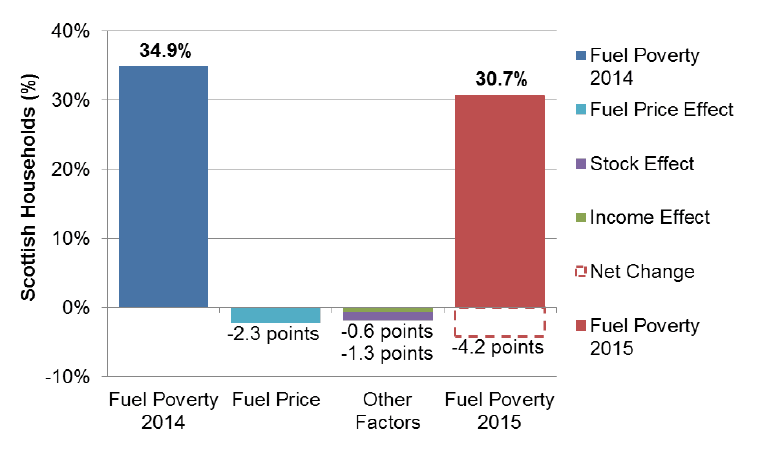
- First, 2015 fuel prices were applied to the 2014 survey sample to determine the effect of price change alone under 2014 levels of energy demand and household income.
- Next, the income of households in this sample was increased by the mean gain observed for their decile group between 2014 and 2015. This demonstrated the additional effect of income on fuel poverty change between 2014 and 2015.
- The remaining difference between the fuel poverty rate modelled at the previous step and the observed rate for 2015 was attributed to the change in energy performance of the housing stock between 2014 and 2015. [50]
Table 34. Steps in Attributing Change in the Fuel Poverty Rate Between 2014 and 2015
| Fuel Poverty Rate | Step Difference | |
|---|---|---|
| Fuel Poverty 2014 | 34.9% | |
| - Step 1: Fuel price change | 32.6% | -2.3 points |
| - Step 2: Income change | 32.0% | -0.6 points |
| - Step 3: Attributed to energy efficiency change | -1.3 points | |
| Fuel Poverty 2015 | 30.7% |
4.4 Characteristics of Fuel Poor Households
161. Figure 23 illustrates some of the key attributes of the fuel poor population in 2015. Around 13% of households living in fuel poverty are families with children. The remaining 87% are almost equally split between older one- or two-person households, on the one hand (43%), and all other types of households with adult residents (44%), on the other.
162. The large majority of fuel poor households are owner occupiers (59%), 27% are social housing residents and the remaining 15% rent in the private sector. Two-thirds of fuel poor households live in houses (67%), broadly equally split between detached, semi-detached and terraced properties. The remaining one-third live in flats (33%).
163. One quarter (25%) of the dwellings of fuel poor households were built before 1919, and 16% were built since 1982. The remaining 59% were constructed in the intervening years.
Figure 23 : Composition of Fuel Poor Households by Selected Household and Dwelling Characteristics, 2015
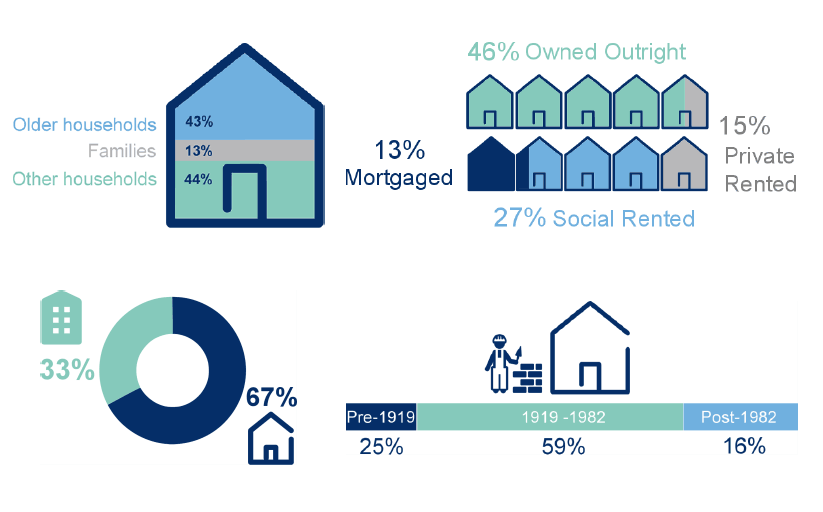
4.4.1 Household Characteristics
164. Table 35 shows fuel poverty rates by a number of household characteristics for 2015 and in comparison to the previous year. Some of the highest and lowest rates of fuel poverty can be seen among private sector residents: 45% of outright owners and 13% of those with a mortgage are assessed to be fuel poor.
165. Older households make up a substantial part of those who own their property outright; they have generally lower income than working age households and their energy needs are assessed under an enhanced heating regime in accordance with the fuel poverty definition. The properties in which they live are often larger, requiring more energy to heat, and are more likely to be detached which leads to greater heat loss. Correspondingly, at 45% older households have higher fuel poverty rates.
Table 35: Fuel Poverty Rates by Household Characteristics, 2015 and 2014
| 2015 | 2014 | |||||
|---|---|---|---|---|---|---|
| 000s | % | Sample | 000s | % | Sample | |
| Tenure | ||||||
| Owned | 341 | 45% | 900 | 354 | 47% | 889 |
| Mortgaged | 97 | 13% | 800 | 125 | 17% | 780 |
| LA/ public | 129 | 38% | 377 | 151 | 42% | 382 |
| HA/co-op | 70 | 28% | 275 | 96 | 36% | 279 |
| PRS | 111 | 33% | 345 | 120 | 37% | 304 |
| Private | 549 | 30% | 2,045 | 599 | 33% | 1,973 |
| Social | 199 | 33% | 652 | 246 | 39% | 661 |
| Household type | ||||||
| Older households | 321 | 45% | 823 | 404 | 50% | 915 |
| Families | 97 | 16% | 676 | 127 | 21% | 667 |
| Other households | 330 | 29% | 1,198 | 315 | 31% | 1,052 |
| Weekly Household Income | ||||||
| < £200 | 273 | 92% | 318 | 282 | 90% | 352 |
| £200-300 | 244 | 56% | 475 | 268 | 61% | 465 |
| £300-400 | 117 | 27% | 463 | 154 | 38% | 439 |
| £400-500 | 50 | 18% | 322 | 67 | 24% | 300 |
| £500-700 | 48 | 11% | 480 | 49 | 11% | 501 |
| £700+ | 16 | 3% | 639 | 25 | 5% | 577 |
| Council Tax Band | ||||||
| Band A | 169 | 36% | 537 | 213 | 42% | 555 |
| Band B | 173 | 31% | 633 | 207 | 37% | 619 |
| Band C | 136 | 33% | 460 | 125 | 34% | 418 |
| Band D | 90 | 27% | 361 | 91 | 29% | 338 |
| Band E | 107 | 31% | 371 | 105 | 32% | 350 |
| Band F | 40 | 23% | 195 | 57 | 27% | 216 |
| Band G - H | 30 | 23% | 133 | 41 | 36% | 126 |
| All Scotland | 748 | 31% | 2,697 | 860 | 35% | 2,634 |
Note: The age threshold for older households in 2015 has changed to 65 for both men and women. This affects comparability with 2014 across household types, except for families .
166. On average the private and the social housing sector have similar rates of fuel poverty: 30 and 33% respectively. There is more noticeable decline in fuel poverty in the social sector, reducing the social-private gap we saw in the SHCS sample for 2014.
167. As in previous years, fuel poverty has a strong association with income and households in the lower income bands have the highest rates of fuel poverty : 92% for the bottom income decile and 56% for the 2 nd bottom decile. Households with income between £300 and £400 a week have seen above average reductions in fuel poverty in the last year, while changes at both the top and the bottom of the household income distribution have been negligible.
4.4.2 Dwelling Characteristics
168. Table 36 shows how the level of fuel poverty varies across dwelling characteristics.
169. The lowest rates of fuel poverty are associated with higher energy efficiency standards. Around one fifth (20%) of households living in post-1982 dwellings are fuel poor, similarly to those living in properties rated C or better. Both of these categories have seen no change since 2014 in terms of fuel poverty levels. Gains in reducing fuel poverty have taken place among those living in pre-1982 dwellings or dwellings rated band D or below.
170. Households using oil as primary heating fuel have seen the largest improvement in fuel poverty levels since 2014, presumably in large part due to the falling price of oil. Just over a quarter of them are now assessed as fuel poor (26%) which is comparable to the level of fuel poverty among those using mains gas (27%). Similarly, the gas network differential has also declined, with 30% of households within the coverage of the gas network being fuel poor, compared to 36% among other households.
171. Rural households have gained disproportionately in the last year with fuel poverty levels falling to 35% from 50% in 2014, at least partly thanks to the lower price of domestic liquid fuels (down by about 30% in the last year). Rural fuel poverty is now close to the level of fuel poverty in urban areas (30% in 2015) and the difference between the two is no longer statistically significant.
172. Levels of fuel poverty among households using electricity as main heating fuel have remained among the highest, at 54%. Although the results suggest that this group may have also experienced some gains since 2014, the sample size is too small to provide enough confidence.
Table 36: Fuel Poverty by Dwelling Characteristics, 2015 and 2014
| 2015 | 2014 | |||||
|---|---|---|---|---|---|---|
| 000s | % | Sample | 000s | % | Sample | |
| Dwelling Type | ||||||
| Detached | 188 | 35% | 678 | 198 | 37% | 672 |
| Semi | 155 | 32% | 586 | 175 | 37% | 547 |
| Terraced | 160 | 30% | 616 | 192 | 37% | 610 |
| Tenement | 153 | 27% | 490 | 169 | 30% | 475 |
| Other flats | 91 | 29% | 327 | 111 | 34% | 330 |
| Age of dwelling | ||||||
| pre-1919 | 190 | 39% | 476 | 206 | 43% | 488 |
| 1919-1944 | 86 | 32% | 314 | 110 | 39% | 286 |
| 1945-1964 | 170 | 32% | 595 | 200 | 38% | 617 |
| 1965-1982 | 184 | 33% | 632 | 205 | 38% | 605 |
| post-1982 | 118 | 20% | 680 | 125 | 21% | 638 |
| Primary Heating Fuel | ||||||
| Gas | 527 | 27% | 1,987 | 573 | 30% | 1,957 |
| Oil | 41 | 26% | 233 | 66 | 49% | 210 |
| Electric | 154 | 54% | 394 | 182 | 60% | 388 |
| Other | 21 | 36% | 78 | 24 | 39% | 79 |
| EPC Band ( SAP 2012) | ||||||
| B - C | 163 | 18% | 923 | 158 | 18% | 833 |
| D | 320 | 30% | 1,161 | 359 | 34% | 1,171 |
| E | 184 | 50% | 452 | 222 | 59% | 458 |
| F - G | 80 | 70% | 161 | 106 | 75% | 172 |
| Location | ||||||
| urban | 603 | 30% | 2,098 | 637 | 32% | 2,064 |
| rural | 145 | 35% | 599 | 208 | 50% | 570 |
| SIMD: Most deprived 15% | ||||||
| Yes | 115 | 31% | 364 | 149 | 38% | 377 |
| No | 633 | 31% | 2,333 | 696 | 34% | 2,257 |
| Gas Grid | ||||||
| On | 607 | 30% | 2,090 | 685 | 34% | 2,077 |
| Off | 141 | 36% | 607 | 161 | 43% | 557 |
| All Scotland | 748 | 31% | 2,697 | 845 | 35% | 2,634 |
173. The fuel poverty rate in the 15% most deprived areas in 2015 stands at 31%, which is the same as the average for Scotland as a whole.
4.5 Fuel Poverty and Income Poverty
174. Although fuel poverty is correlated with low income, it is not equivalent to income poverty. This sections updates previous analysis of how these two conditions relate in the household population.
175. According to the official poverty definition, individuals are considered to be in relative (income) poverty if their equivalised net household income is below 60 per cent of the median income in the same year. Official poverty estimates are calculated using the Department for Work and Pensions' ( DWP) Family Resources Survey ( FRS). The latest estimates for Scotland were published on 28 June 2016 and relate to 2014/15. [51]
176. It is possible to use the SHCS to determine how fuel poverty and income poverty relate, although there are some caveats to this approach. One of the main caveats is that the SHCS does not collect the full range of household income data used to derive the official measure of poverty. For example, income information is only collected for the head of the household and their spouse/partner. As a result, the SHCS would underestimate the income of households with more than two earners, and therefore over-estimate levels of income poverty. To correct to some extent for this we make a corresponding adjustment to the equivalisation method used for producing official poverty statistics. It is therefore important to note that the results presented here do not reproduce exactly the official measure of fuel poverty and are only approximate.
177. A further caveat is that the latest published income poverty estimates relate to 2014/15. In order to derive a poverty threshold figure for 2015 we use the relationship between the SHCS and the FRS estimates of the median equivalised household income for the previous year, 2014. We adjust the 2015 SHCS median by the ratio between the two estimates observed in 2014 to obtain a 2015 poverty threshold. We estimate this as £291 per week before housing costs ( BHC) for a couple without children.
178. As Table 37 shows around half of all fuel poor households would be considered poor in terms of their income (48% or 359,000) while the other half have incomes above the relative poverty threshold (52% or 389,000 households).
Table 37: Estimated Number and Proportion of Households by Fuel Poverty and Income Poverty Status, SHCS 2015
| Income Poor | Not Income Poor | All | ||
|---|---|---|---|---|
| Fuel Poor | 000s | 359 | 389 | 748 |
| % | 48% | 52% | 100% | |
| Not Fuel Poor | 000s | 87 | 1,599 | 1,686 |
| % | 5% | 95% | 100% | |
| All | 000s | 446 | 1,988 | 2,434 |
179. Figure 24 sets out this information graphically. While those living in income poverty have a very high risk of experiencing fuel poverty (8 out of 10 do), the opposite is not necessarily true. Around half of all fuel poor households are not income poor.
Figure 24: Fuel Poor and Income Poor Households, SHCS 2015
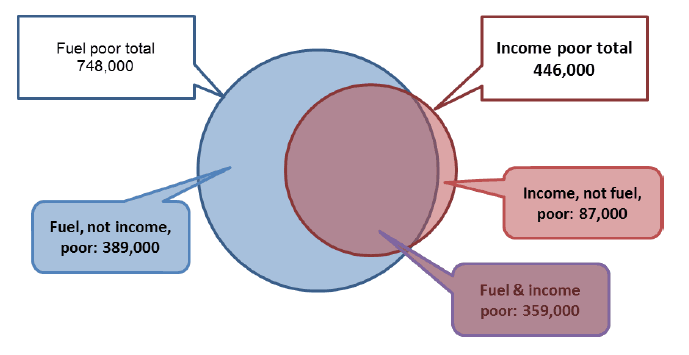
180. Table 38 provides further information about the characteristics of the households who fall into the different sub-groups.
181. Households who are both poor and fuel poor tend to live in more energy efficient dwellings. They are more likely to use gas for heating and live in urban locations, compared to other fuel poor households. These characteristics point to low income as a key reason for their experience of fuel poverty. These households are more likely to include families with children compared to other fuel poor households.
182. On the other hand, those who are not poor but experience fuel poverty have high likelihood of living in low energy efficiency properties, more than other fuel poor households and well in excess of the average for Scotland. Among these households the share of electricity use for heating is higher and the use of mains gas is lower. Such households are more likely to live in rural locations and include a higher share of older households compared to other fuel poor households and the rest of Scotland.
Table 38: Household and Dwelling Characteristics by Poverty and Fuel Poverty, 2015
| Fuel, not Income Poor |
Fuel & Income Poor | All Fuel Poor |
Income, not Fuel Poor |
All Scotland | ||
|---|---|---|---|---|---|---|
| EPC Band ( SAP 2012) | ||||||
| B-C | 000s | 49 | 115 | 163 | 55 | 897 |
| col % | 12% | 32% | 22% | 63% | 37% | |
| D | 000s | 151 | 169 | 320 | 29 | 1,057 |
| col % | 39% | 47% | 43% | 34% | 43% | |
| E-G | 000s | 189 | 75 | 264 | 3 | 480 |
| col % | 49% | 21% | 35% | 3% | 20% | |
| Household Type | ||||||
| Older | 000s | 177 | 145 | 321 | 14 | 713 |
| col % | 45% | 40% | 43% | 16% | 29% | |
| Families | 000s | 40 | 57 | 97 | 44 | 594 |
| col % | 10% | 16% | 13% | 50% | 24% | |
| Other | 000s | 172 | 157 | 330 | 29 | 1,126 |
| col % | 44% | 44% | 44% | 34% | 46% | |
| Urban-Rural | ||||||
| Urban | 000s | 281 | 322 | 603 | 78 | 2,020 |
| col % | 72% | 90% | 81% | 89% | 83% | |
| Rural | 000s | 107 | 37 | 145 | 10 | 414 |
| col % | 28% | 10% | 19% | 11% | 17% | |
| Primary Heating Fuel | ||||||
| Gas | 000s | 241 | 286 | 527 | 77 | 1,926 |
| col % | 62% | 80% | 70% | 88% | 79% | |
| Oil | 000s | 29 | 12 | 41 | 3 | 160 |
| col % | 7% | 3% | 6% | 3% | 7% | |
| Electric | 000s | 106 | 48 | 154 | 6 | 284 |
| col % | 27% | 13% | 21% | 6% | 12% | |
| Other fuels | 000s | 11 | 10 | 21 | 2 | 59 |
| col % | 3% | 3% | 3% | 2% | 2% | |
| Gas Grid | ||||||
| On grid | 000s | 286 | 320 | 607 | 82 | 2,038 |
| col % | 74% | 89% | 81% | 94% | 84% | |
| Off grid | 000s | 102 | 39 | 141 | 5 | 396 |
| col % | 26% | 11% | 19% | 6% | 16% | |
| Sample size | 486 | 395 | 881 | 86 | 2,697 | |
Contact
There is a problem
Thanks for your feedback